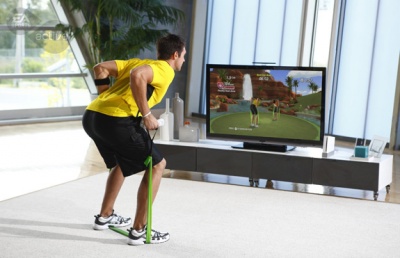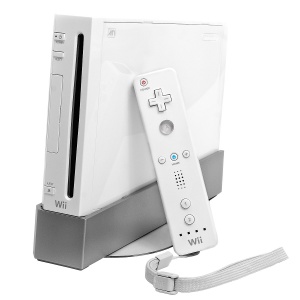Fitness Game
Fitness Game is a term that refers to the type of online video game that specifically demands players to execute physical exercise as a part of the gameplay. Although companies like Nintendo and Konami have introduced the concept of fitness game in the 1980's-1990's, the cost for the supporting technology was expensive and its technological capability was still behind in fully grabbing consumers' attention. Nonetheless, the introduction of motion control by Nintendo's Wii and Microsoft's Xbox enhanced both the features and the efficiency of fitness game. As a result, the field of fitness game became more attention-grabbing and more consumers became willing to get the benefit of exercising by playing fitness game.
Contents
Current Examples
Some well-known examples of the motion control fitness game include Wii Sports Club[1], Just Dance[2], and Nike+ Kinect Training[3]. Also, the launch of wearable like Fitbit[4] and Apple Watch[5] initiated many developments to the fitness game industry due to wearable's feature of tracking heartbeat; one of the examples of fitness game that utilizes wearables would be Exantra World[6].
Before the 21st century
Because the overall development of fitness game mostly relies on technology, the field of fitness game was still in its beginning stage before the 21st century. Yet, there were a couple products that introduced the idea and the potential success behind fitness game.
Life Fitness Exertainment System
The Life Fitness Exertainment System is an exercise bike made by Life Fitness (a manufacturer of exercise equipment) in collaboration with Nintendo. It was released in the US in the 1990's and offered compatibility with the Super Nintendo console. Designed to allow the player to exercise while playing video games, Life Fitness Exertainment System shows similarity with Wii Fit, only the system was produced over a decade earlier. A few games were designed to be used with the Exertainment bike, like Speed Racer in My Most Dangerous Adventures[7] and Exertainment Mountain Bike Rally[8]. Although the idea behind this product was straightforward, there were multiple problems that arose and ultimately marked the failure of this project. The first problem was the cost of the system. That the model itself was significantly more expensive than a typical exercise bike. There were also additional costs of the electronics to institute the gaming features. The high production costs made it inefficient for mass production. There were also problems with production quality. The model was not durable and broke easily. The issue of durability is one of the most significant problem for any fitness equipment to have and thus gave this model a negative reputation on the market. Lastly, users often found operating the gaming software intimidating. The software lacked instructions on how to use the product , and users felt uncomfortable having to employ software knowledge in order to exercise.
Dance Dance Revolution
Dance Dance Revolution (DDR) was produced by a Japanese entertainment and gaming company called Konami in 1998. DDR is a music video game series that pioneered the rhythmic dancing game market. To play, players stand on a dance platform and step on the colored arrows according to the visual cues which follow along to the rhythm of a song. Once the round is finished, players are judged by how well they timed their "dance" steps. Players earn a higher score if they accurately connected with visual cues with the rhythm. The winning player has the option to continue to the next round and play again. Dance Dance Revolution has been given much critical acclaim for its originality and longevity in the video game market. There have been numerous arcade-based launches across 20 countries and hundreds of home video game console releases. Ultimately, Dance Dance Revolution has promoted a music library of original songs produced by Konami's artists and a set of licensed music from many different genres while prompting inspiration for similar musical games.
After the 21st century
Beginning from 21st century, especially during 2010's, is when the field of fitness game made a dramatic development due to a simultaneous technological advancement. Throughout the 21st century, many technological developments were made and became a major part of the newest fitness game; such developments include motion control and wearables.
Nintendo's Wii
Released in November 2012 by Nintendo[9], the Wii U is the first eighth-generation video game console presented in the video game market[10]. The Wii U is also the first video game console to introduce the concept of motion control, a technological capability to accurately depict player's physical motion and encrypt such motion into the gaming interface; this feature greatly enhanced the efficiency of fitness game because it can track the exact motion, thus creating a more interactive gaming interface for the players while getting a more efficient and rigorous exercises. Below is the list of Wii games that utilize motion control.
| Name of the game | Released Year | Exercise Type |
|---|---|---|
| Wii Fit | 2007 | Interactive Mini Games |
| Wii Fit Plus | 2009 | Interactive Mini Games |
| Wii Fit U | 2013 | Interactive Mini Games |
| Wii Sports | 2006 | Sports-based Game |
| Just Dance 2016,2017,2018 | 2016, 2017, 2018 | Rhythmical Dance Game |
| Wii Street U | 2013 | Augmented Reality |
| Your Shape: Fitness Evolved 2013 | 2013 | Virtual Training Game |
| Zumba Fitness World Party | 2013 | Rhythmical Dance Game |
Smartphone, Wearables, and Exantra World
A dramatic technological development of the smartphone and the wearable has been giving a significant influence to the field of fitness game; unlike other gaming consoles/equipments, smartphone and wearables show a great portability and great technological features, thus allowing users to have a more efficient exercise while experiencing high-end technological gaming interface. Although there are numerous fitness app that utilize both smartphone and wearable technology for people to have a better workout experience, there never has been a fitness game that incorporated both technologies.
Exantra World is the first Online Role-Playing fitness app (iOS) that allows players to build their own avatar, so-called Titan, and prompts users to strengthen their Titans by statistically increasing their abilities with virtual points. Once their Titans get strong enough, users can then control them to compete with other Titans. What makes Exantra World highly advanced in technology is its simultaneous utilization of wearable technology and a smartphone; when the user begins to exercise, wearable measures the increase in user's heart rate, analyzes the heat-rate intensity, and sends that data to the game; then the game converts that data into virtual points which the user can later spend those points to develop his or her own Titan and play the role-playing game. Exantra World is currently undergoing a public fundraising via Kickstarter.com and have successfully raised $18,280[11] and met its initial goal of $15,000 pledged.
Ethical Concerns
One of the greatest concerns facing fitness game is that of health information privacy and its utilization. As wearables are actively playing a role in fitness game, many aspects of fitness game changed largely due to wearables' technological capabilities of easily collecting user's health data, transmitting such data to other devices, and utilizing such data to acquire further information about player's health. Seemingly healthy and enjoyable to play, many fitness games have been subjected to ethical issues such as the tracking of one's health information and the credibility of physical exercises.
Health Information and its utilization
Initially, users played fitness game during late 1990's and throughout 2000's did not have an issue with the sharing of health information as well as its utilization. However, sharing and using user's health information became the major ethical issue of the fitness game as video-game companies began incorporating modern technology to their fitness game developments. For example, in case of Exantra World, the player is continuously exposed to the game interface and the wearable while he or she is playing the game; once the wearable have accumulated enough health information about the player, the wearable will then transmit that information to the smartphone device that would convert the player's health information into a virtual points. Example above illustrates the circumstance in which player's health information could be exposed to the entire gaming interface and therefore is not secured. Possible consequences of this would be publicizing one's health information, a data that can be sensitive to a certain user.
Credibility of Generalized Workout
This issue is not as major compared to the issue of unsecured health information, but it fundamentally questions the efficiency of many fitness games out at the market. In real life, a personal trainer has the personal trainer certification, like American Council on Exercise (ACE)[12] or National Academy of Sports Medicine (NASM)[13] to certify that he or she is giving a set of credible and efficient exercises that are personally suited to the client. But the fitness game is not the case; there is no certification that give credibility to the type of exercise that the player can do via fitness game. In other words, there is no guarantee that the type of exercises that a player can do through the fitness game is going to be beneficial. Considering the condition that most of the fitness game prompts user to execute cardiovascular exercise, this issue may not be as serious as how this issue is presented in this page. However, a fitness game like Exantra World demand users to execute non-cardio exercise, a type of workout that tends to require a customization for a more efficient result; examples of non-cardio exercises include weightlifting, yoga, isometrics, etc. Being that generalizing non-cardio exercises by prompting users to do exercises without any specification or customization can lead to many health issues like improper execution form and muscle mass imbalance, the quality of non-cardio fitness game remains questionable.
References
- ↑ "Nintendo Webiste" https://www.nintendo.com/games/detail/23dwBGv7QCFrP08BKcqDpsq-6hxvaaTB
- ↑ "Just Dance Ubisoft Website"https://just-dance.ubisoft.com/en-us/home/
- ↑ "Nike+ Kinect Training Demo https://www.youtube.com/watch?v=CoM_MNZ5pzU
- ↑ "Fitbit Wesbite"https://www.fitbit.com/home
- ↑ "Apple Watch Website"https://www.apple.com/apple-watch-series-3/?afid=p238%7Cs2QbmM6cp-dc_mtid_1870765e38482_pcrid_224100368864_&cid=aos-us-kwgo-watch--slid--product-
- ↑ "Exantra World Website"https://www.exantraworld.com/
- ↑ "Nintendo Wikia of Speed Racer in My Most Dangerous Adventures"http://nintendo.wikia.com/wiki/Speed_Racer_in_My_Most_Dangerous_Adventures
- ↑ "Nintendo Wikia of Exertainment Mountain Bike Rally"http://nintendo.wikia.com/wiki/Exertainment_Mountain_Bike_Rally
- ↑ "Wii U Confirmed Release Date"http://metro.co.uk/2012/01/26/wii-u-confirmed-for-europe-this-year-297126/
- ↑ "Article about eighth-generation console"http://www.businessinsider.com/nintendos-project-cafe-will-gamers-feel-the-buzz-2011-5
- ↑ "Kickstarter Website for Exantra World"https://www.kickstarter.com/projects/624726783/exantra-world-fitness-rpg-role-playing-game
- ↑ "ACE Website"https://www.acefitness.org/fitness-certifications/personal-trainer-certification/default.aspx?utm_campaign=Banner_Ads&utm_content=PT_Career_Guide_160x600#personal-trainer-marketing-download&utm_source=Rakuten&utm_medium=4&ranMID=42334&ranEAID=nuU3r0LI7IY&ranSiteID=nuU3r0LI7IY-z4ahl3I7Oi5OJxyKDUbk1g
- ↑ "NASM Website"https://www.nasm.org/become-a-personal-trainer?utm_source=cj&utm_medium=affiliate&utm_campaign=Bolt+Fitness&utm_content=7356170




